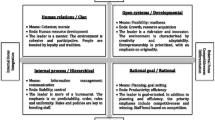Abstract
Trust is widely recognised is a core feature of partnership relationships and one that facilitates joint work. It is an issue that must be addressed if partnerships are to enhance service system integration. In recent literature trust has been linked to concepts of risk and control. In this study of trust within a Primary Care Partnership (PCP) in Australia the experiences of risk and uncertainty, and control, of participants in different structural positions, were explored in detail. The data used in this paper was qualitative, derived from 63 interviews with managers and service providers participating in committees of the PCP. This paper reports on the differences in the experience of risk and uncertainty, trust and control, of managers and service providers working as boundary spanners through the committees of a PCP. For managers there were significant risks and uncertainties, and trust and control were important. For service providers there were few risks and uncertainties, and trust and control were of much less importance. Some policy implications of the differences in perspective are discussed, as are important areas for further research.

Similar content being viewed by others
References
Alexander, E. R. (1995). How organizations act together: Interorganizational coordination in theory and practice. Amsterdam: OPA.
Alter, C., & Hage, J. (1993). Organizations working together. Newbury Park: Sage.
Bachmann, R. (2001). Trust, power and control in trans-organizational relations. Organization Studies, 22(2), 337–365.
Barber, B. (1983). The logic and limits of trust. New Brunswick: Rutgers University Press.
Costa, A. C., & Bijlsma-Frankema, K. (2007). Trust and control interrelations: New perspectives on the trust-control nexus. Group & Organization Management, 32(4), 392–406.
Covey, S. M. R., & Merrill, R. R. (2006). The speed of trust: The one thing that changes everything. New York: Free Press.
Das, T. K., & Teng, B.-S. (1998). Between trust and control: Developing confidence in partner cooperation in alliances. The Academy of Management Review, 23(3), 491–512.
Das, T. K., & Teng, B.-S. (2001). Trust, control and risk in strategic alliances: An integrated framework. Organization Studies, 22(2), 251–283.
Delarue, H. (2005). Relational risk perception and alliance management in French biotechnology SMEs. European Business Review, 10(6), 532–546.
Department of Human Services. (2000). Going forward: Primary care partnerships. Melbourne: Department of Human Services.
Epstein, S. (1994). Integration of the cognitive and the psychodynamic unconscious. American Psychologist, 49(8), 709–724.
Ezzy, D. (2002). Qualitative analysis: Practice and innovation. Crows Nest: Allen & Unwin.
Galbraith, J. R. (1995). Designing organizations: An executive briefing on strategy, structure and process. San Francisco: Jossey-Bass.
Joffe, H. (2003). Risk: From perception to social representation. The British Journal of Social Psychology, 42, 55–73.
Kanter, R. M. (1994). Collaborative advantage: The art of alliances. Harvard Business Review (July–August), 96–108.
Knight, F. H. (1921) [reprinted in 1964]. Risk, uncertainty and profit. Reprints of economic classics. New York: Sentry Press.
Leifer, R., & Delbecq, A. (1978). Organizational/environmental interchange: A model of boundary spanning activity. The Academy of Management Review, 3, 40–50.
Mankin, D., Cohen, S., & Fitzgerald, S. P. (2004). Developing complex collaboration: Basic principles to guide design and implementation. In M. M. Beyerlein, D. A. Johnson, & S. T. Beyerlein (Eds.), Complex collaboration: Building capabilities for working across boundaries. Amsterdam: Elsevier.
Mollering, G. (2005). The trust/control duality: An integrative perspective on positive expectations of others. International Sociology, 20(3), 283–305.
Mollering, G. (2006). Trust, reason, routine. Reflexivity. Amsterdam: Elsevier.
Reddy, S. G. (1996). Claims to expert knowledge and the subversion of democracy: The triumph of risk over uncertainty. Economy and Society, 25(2), 222–254.
Reed, M. I. (2001). Organization, trust and control: A realist analysis. Organization Studies, 22(2), 201–228.
Ring, P. S. (1997). Processes facilitating reliance on trust in inter-organizational networks. In M. Ebers (Ed.), The formation of inter-organizational networks (pp. 113–145). Oxford: Oxford University Press.
Scott, W. R. (2001). I nstitutions and organizations (2nd ed.). Thousand Oaks: Sage.
Slovic, P. (2001). The risk game. Journal of Hazardous Materials, 86, 17–24.
Slovic, P., Finucane, M. L., Peters, E., & MacGregor, D. G. (2004). Risk as analysis and risk as feelings: Some thoughts about affect, reason, risk and rationality. Risk Analysis, 24(2), 311–322.
Stern, R., & Green, J. (2005). Boundary workers and the management of frustration: A case study of two Healthy City partnerships. Health Promotion International, 20(3), 269–276.
Stiles, J., & Williams, P. (2004). The impact of collaborative motivation on complex multi-agency partnerships: A case study of the United Kingdom. In M. M. Beyerlein, D. A. Johnson, & S. T. Beyerlein (Eds.), Complex collaboration: Building capabilities for working across boundaries. Amsterdam: Elsevier.
Van de Ven, A. H. (1976). On the nature, formation, and maintenance of relations among organizations. The Academy of Management Review, 1, 24–36.
Vangen, S., & Huxham, C. (2003). Nurturing collaborative relations: Building trust in interorganizational collaboration. The Journal of Applied Behavioral Science, 39(1), 5–31.
Walker, R., Bisset, P., & Adam, J. (2007). Managing risk: Risk, trust and control in a primary care partnership. Social Science & Medicine, 64(4), 911–923.
Williams, P. (2002). The competent boundary spanner. Public Administration, 80(1), 103–124.
Williams, G. (2006). Infrastructure of responsibility: The moral tasks of institutions. Journal of Applied Philosophy, 23(2), 207–221.
Zaheer, A., McEvily, B., & Perrone, V. (1998). Does trust matter? Exploring the effects of interorganizational and interpersonal trust on performance. Organization Science, 9(2), 141–159.
Acknowledgements
The authors wish to acknowledge funding received for this project from the National Health and Medical Research Council of Australia.
Author information
Authors and Affiliations
Corresponding author
Rights and permissions
About this article
Cite this article
Walker, R., Smith, P. & Adam, J. Making Partnerships Work: Issues of Risk, Trust and Control for Managers and Service Providers. Health Care Anal 17, 47–67 (2009). https://doi.org/10.1007/s10728-008-0094-8
Received:
Accepted:
Published:
Issue Date:
DOI: https://doi.org/10.1007/s10728-008-0094-8




